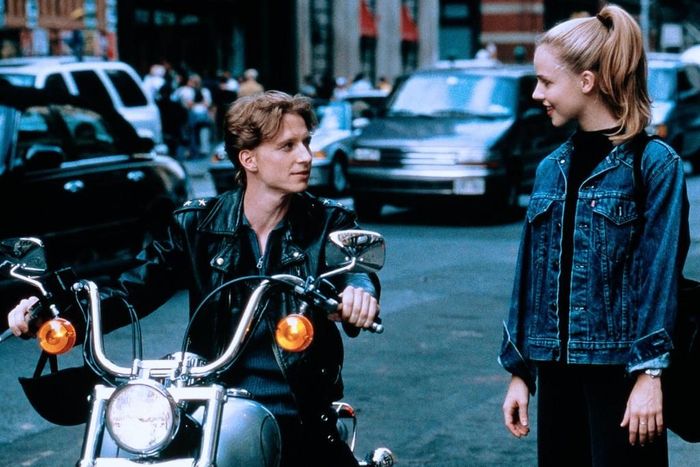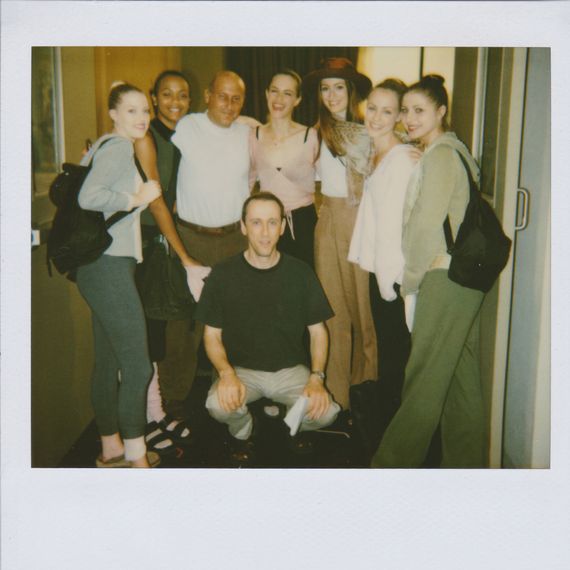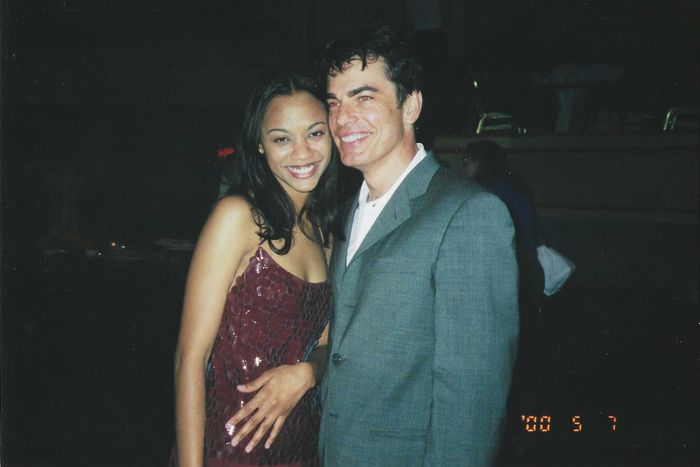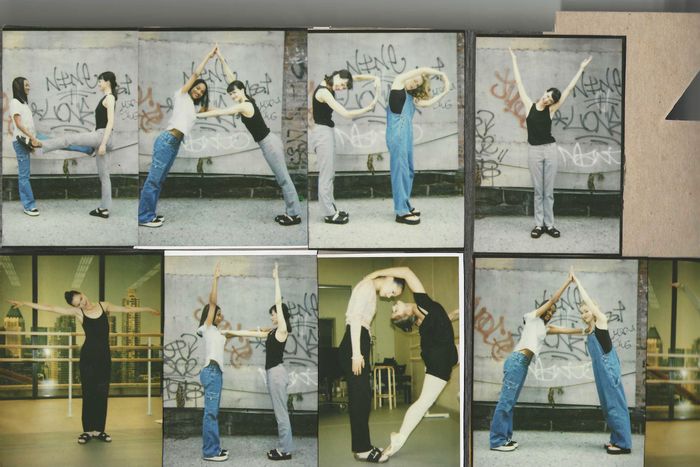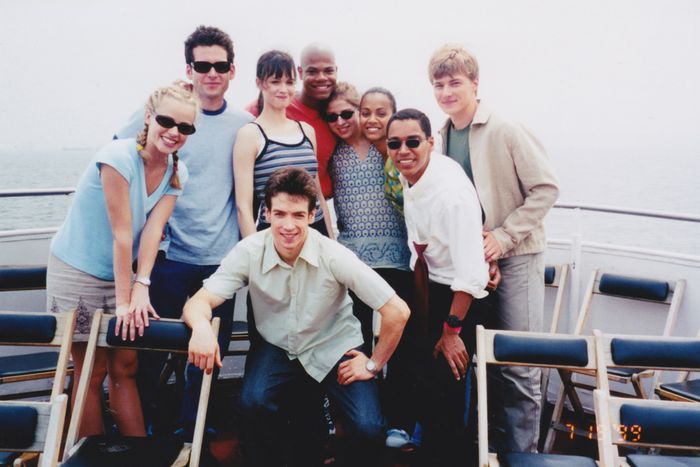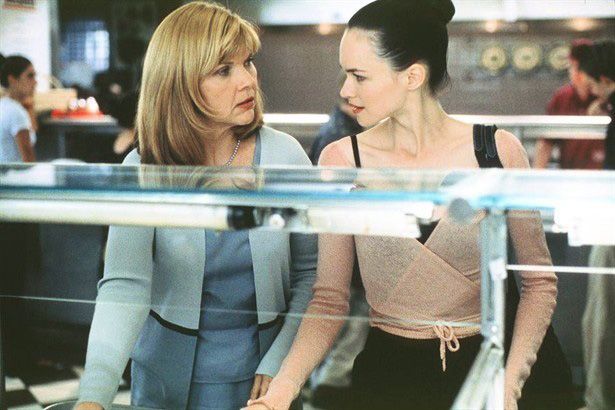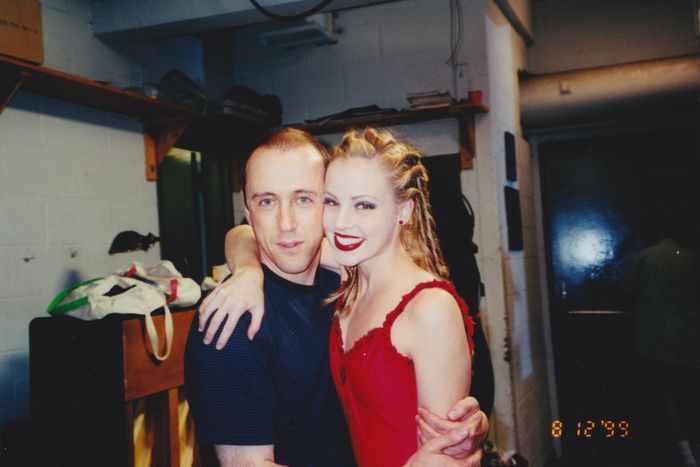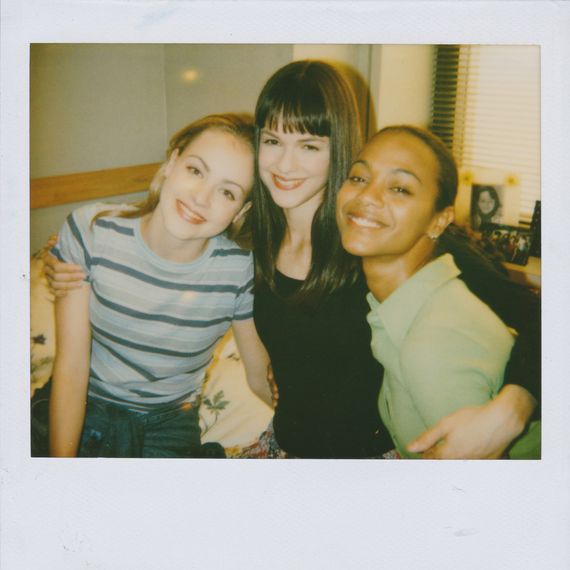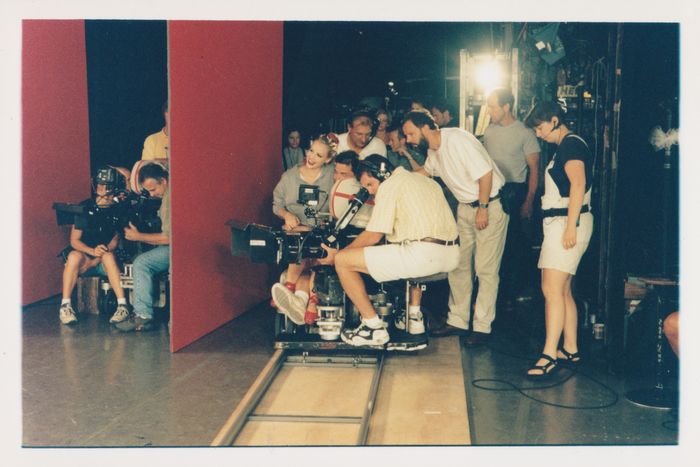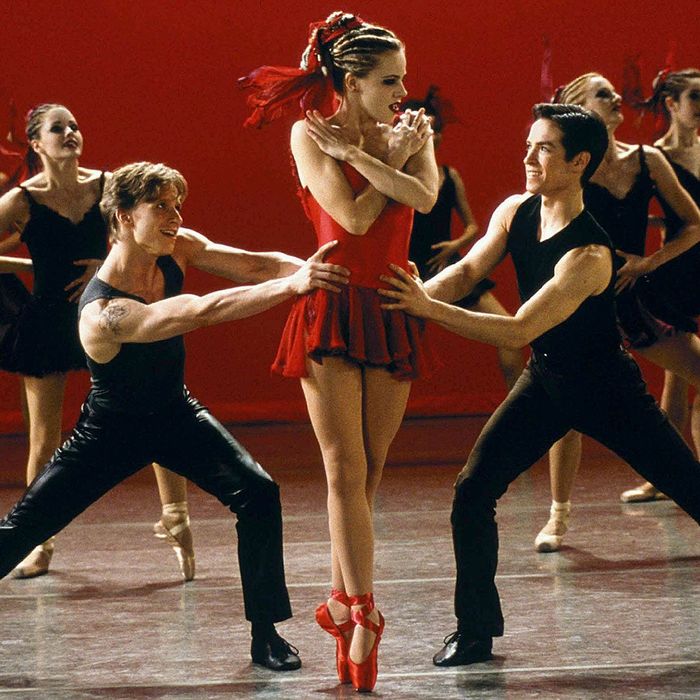
The year 2000 was boom times for teen movies, which is what Center Stage looks like at first glance. A motley crew of young ballet dancers from around the country is thrown together in a pressure-cooker environment, where they fall in love, fall out of friendships, and find themselves. There are training montages and close-ups of pointe shoe–mangled feet. We’d seen some version of this movie many times before, and the reviews said as much. Variety called it “an uneven, mildly entertaining divertissement” and complained that it borrowed too many plot points from other dance and show-business films. Entertainment Weekly said it was “the same old stuff, not an arabesque more: shredded slippers, shredded nerves, shredded bodies, and, to the lucky few, an armload of roses.” (Roger Ebert was kinder, saying that it was smart and perceptive, and “about something … about the union of hard work and artistic success.”)
But 20 years later, Center Stage is arguably the defining dance movie of its generation, the rare example of its kind that enjoys as much affection among dancers as it does among civilians. It might have seemed like a disastrous mismatch of a project: a decorated British theater director at the helm of an American ballet movie stocked with untested acting talent (it was Zoë Saldana’s first feature) and dancers in their first film roles, feigning struggle to the sounds of Mandy Moore’s “I Wanna Be With You” and Jamiroquai’s “Canned Heat.” But Nicholas Hytner proved determined to take Center Stage seriously. Armed with a screenplay by Empire Records’ Carol Heikkinen (punched up by legendary playwright Wendy Wasserstein), Hytner spent the summer of 1999 filming in the heart of New York City’s dance scene. In interviews with Vulture, eight of the main cast members, the producer, the costume designer, the choreographer, and a dance double share memories of how white-knuckle auditions and 3 a.m. takes at Lincoln Center, 24 pairs of leather pants and a single tearaway tutu, amounted to one of the most unforgettable shoots of their careers.
Auditions: ‘Let’s Get People Who Can Really Really Really Dance’
Center Stage tells the story of 12 young dancers handpicked to train at the American Ballet Academy, loosely based on the School of American Ballet. Nicholas Hytner set the tone of the film’s casting process early on: authenticity. Of the primary characters, three were played by actual American Ballet Theater dancers — Ethan Stiefel, Sascha Radetsky, and Julie Kent. But casting directors traveled across the country in search of a professional ballerina who could carry the star role of Jody Sawyer: “Any place there was a ballet company, I think, the casting folks were visiting.”
Ethan Stiefel, Cooper Nielson: It was a time where I didn’t have a cell phone and was still getting messages and stuff at [American Ballet Theater] in the pigeon holes the dancers have … there was that iconic pink message slip in my cubby hole, and it simply said, “Laurence Mark, Columbia Pictures, please call.”
Larry Mark, producer: Amy Pascal, who ran Sony in the day, had always wanted to do a dance movie. She had had a script developed, one draft of it, by Carol Heikkenen. I had just gotten over to Sony with a production deal, and she said, “Larry, this might be a good movie for you to hop on.”
At the time all it was was a script, and I read it and I was fascinated by it. In a way that wasn’t schmaltzy, it seemed to be aspirational. It seemed to encourage young folks to go to ballet class, no matter what your body.
The first person I thought of to direct this was Nick Hytner, with whom I had just done The Object of My Affection. Nick was looking for his next movie, and I thought, who better to do something, particularly in the musical arena, than Nick, who had done Miss Saigon and any number of amazing stage musicals and stage plays. He came onboard and that was the beginning of it.
Stiefel: I called Larry and he just said, “We’re putting together this film. It’s in the early stages, but I’ve seen your work and really admire your performing, and would you be interested?”
Mark: I’ve always been a fan of ABT, that’s for sure. I think I’d seen him do something there and just thought he had amazing charisma. Amy and I went to see an ABT performance in Los Angeles, and we went backstage and visited with Ethan.
Stiefel: After recovering a bit from the shock, I said, “Yeah, absolutely,” and he described from there the process a bit, just in terms of having to do some readings and meet with the director. It was kind of wild, from that message slip to seeing it happen.
Mark: We were trying to be as authentic as possible, and that’s why we were always very conscious of going for boys and girls who could dance really well. We were trying not to fudge the dancing. That was a Nick Hytner edict: Let’s get people who can really really really dance to do this movie.
Sascha Radetsky, Charlie: Ethan and I were really close friends — we have been since we were little kids — and I remember that he had signed on to this project. I think that’s when I first became aware of it, just that he was doing a movie.
And then in the spring of ’99, the auditions started. Everyone knew about it. [New York] City Ballet, ABT. We’re the big classical and neoclassical companies in New York, and we all knew about it. A lot of people were auditioning.
Stiefel: It had been a long time since a dance movie had been made, certainly one that featured dancers as actors. So I think in general people were really intrigued and excited.
Susan Stroman, choreographer: [It] was kind of ahead of its time, you know — this was before Glee or before the dance TV shows that are on now. To do a pure dance movie, a movie that was celebrating dance and also a movie that at the end the girl ballerinas all have a mind of their own — it was ahead of its time. So I think people really wanted to be a part of it.
Amanda Schull, Jody Sawyer: I was in a rehearsal for the end of the year student showcase with the San Francisco Ballet School. We were rehearsing a contemporary piece that was being choreographed by one of the company members, and she said, “We’re going to have a fancy Hollywood producer come in today.” We learned later it was a casting director. And apparently, a casting director had already been to see the company. She had gone across the country — started in New York and gone to a few companies across the country because they wanted to find a dancer for the role of Jody.
Mark: We were all over the map. We were auditioning practically everywhere. We sent people into various cities. Any place there was a ballet company, I think, the casting folks were visiting.
Radetsky: I originally went in to audition for the Russian guy, Sergei. I did live in Russia and study there and speak decent Russian, but my accent isn’t very good.
Mark: [The role of Sergei went to] Ilia Kulik, an Olympic figure skater who managed most of the dancing, because dance and figure skating — there’s a lot in common. He in our view qualified as someone who was a proper dancer.
Radetsky: The role of Charlie, which I eventually landed, was [originally named] Carlos. He was a Hispanic dude, and at that time there were some really special up-and-coming young Latino male dancers like Joaquin de Luz, Angel Corella. Julio Bocca was in his prime. There were a bunch of them. And I think the role of Carlos went to Angel. I don’t know if he signed anything, but that was the scuttlebutt.
We were mid-Met season, which is two months at the Metropolitan Opera House, where we do eight shows a week and a different program each week. So we were doing this ballet, Snow Maiden, and it has kind of a slippery floor … there was a rash of injuries that week, and among them, Angel. He blew out his ankle. So then I got a call to come back to audition for the role of Carlos. Then I got it, and they changed it to Charlie. So unfortunately, Angel’s misfortune was I guess my advantage.
Mark: We’d certainly talked to Angel about it for a few moments. He wasn’t cast in the role, but we had spoken to him about it. I think what seemed to occur in a way was almost a script issue. That we all, including the studio, felt it was kind of in the moment more fun and cool to have a boy next door in that role. And Sascha, despite his name, is an American boy next door. And there were also scheduling issues with Angel, there were any number of hurdles, but the creative one was that the role itself was slightly reimagined as we went along, and Sascha was more appropriate for it.
Schull: The assistant from the company came to me and she said, “They want to put you on tape tomorrow and here’s the script.” But I didn’t get to choose the time, so I was taken right after rehearsal. I was sweating. I was beet red. I had no makeup on and I went straight into the audition.
Afterwards [the casting director] said to me, “Do you mind stepping outside, looking at these sides and coming back in, and reading for the role of Maureen?” And I said to her, “Oh, yes, I like this part better. I’d like this part please.” So I stepped outside, and later she told me that the reason she had me step outside is because she called her boss and she said, “I found Jody, I’m just getting a little bit more of her on tape.”
Mark: Amanda Schull, that was one of those ones where you’re just seeing every girl who seems to fit the bill. Amanda came in and combined all the qualities that the character as written required. She was lovely and appealing and graceful and energetic.
Schull: I found out that they wanted to do a producer session with me in Los Angeles, and the company wouldn’t let me go until after the showcase. My whole family flew in from Hawaii to see me. And then I sort of like peaced out on my family and flew on a 7 a.m. flight the day after down to Los Angeles.
And that was the first time I met Nick Hytner. Ilia Kulik was in the waiting room. That was so over the top exciting for me because he just won the gold medal in the Olympics, and he was the first man to ever do a quad during the Olympics. I read for Nick, and he gave me some notes. I remember having a good rapport with him.
I didn’t hear from them again for a few more days. Then they called and said they want to do a screen test. So they flew me from Hawaii [to New York] and I did the screen test there, and they put me up in a hotel and it was all just kind of like, If this is all, I guess this is pretty good. I’ve made it. And then within a couple days after the test I was told I had the role and I was going to be going back to New York.
‘I Don’t Want To Be the Obvious Fake in the Middle of All This’
For some roles, like the talented-but-jaded Eva Rodriguez and the star student living with an eating disorder, Maureen, the casting team was willing to prioritize acting talent over ballet ability and hire dance doubles to make up the difference. Some cast members, like newcomer Zoë Saldana, were game to jump onboard. Others, like Broadway veteran Donna Murphy, had concerns.
Zoë Saldana, Eva Rodriguez: I had just gotten my SAG card a year before, by doing a Verizon commercial I think. So I was learning but I was just very happy-go-lucky. In my mind, I was like, Oh, well I can dance. And this girl [Eva], yes, she’s from Boston, but I’m from New York — from Queens. I think we have a lot in common.
Susan May Pratt, Maureen Cummings: I remember my agents asking me months ahead, “Do you have any ballet experience?” And I was like, “Yeah, I took classes.”
A really good friend of my mom was a ballet teacher where I grew up, and I went back to East Lansing and took a weekend intensive, where she sort of tried to teach me ballet in two days, and then I remember her saying at the end of the weekend, “I wish I had you for a year, I could really make something out of you!”
Saldana: They knew that I was not a professional ballet dancer. I think I’d stopped dancing three years or two years before that. So they wanted to see how I could move.
When I met Nicholas Hytner, he was just so sweet. He cut me off in the middle of the second scene that I was auditioning with, and he said, “That’s okay, I don’t need to see any more.” And I remember I was really thrown by that, and I thought, “Well, they’re probably going to shake my hand and they’re going to tell me to leave.” And that really happened. He was like, “I’ll see you soon, Zoë,” and I was like, “Oh! What does that mean?”
Then I got the call that afternoon and I found out I got the part. And it was my first film. I was ecstatic.
Pratt: I remember being at the ballet audition and trying to follow along with the directions. I was doing better than a lot of the girls who were with me in the room but still not fantastic, and I just remember the choreographer being like, “Well, maybe she’ll do.”
Donna Murphy, Juliette Simone: I read the script, and I said, “This is ridiculous. I mean, I’m not a trained dancer.” The script would read, “Juliette jetés across the room” and “she demonstrates this” and “she demonstrates that.” I thought I should be seen for the role that Deb Monk played, [Maureen’s] mom.
I went in and I did my audition and towards the end of the audition, Nick Hytner said, “Why in the world would you not want to play this role?” He said, “I’ve seen you on Broadway. You’re a dancer.” I said, “No, not this kind of dancer, Nick, not a ballet dancer … I don’t want to be the obvious fake in the middle of all this, who’s teaching.”
He said, “But I just see you as Juliette.” I didn’t know exactly what that meant but I wasn’t out of there long before my agent called and said, “They want to offer you this role.” And I said, “They need to agree to put me in training, basically tomorrow, to acquire as much as I can. And I advise them to shoot me from the waist up. I’ll work intensely on my port de bras.”
Peter Gallagher, Jonathan: I don’t know whether I had to audition or whether it was an offer, or whether I met first, but I just remember that it was about ballet and Nick Hytner was directing it. And Nick Hytner, you know … well okay, I’m in.
Eion Bailey, Jim Gordon: When I auditioned for it I was sure that I was not going to get it. I thought I was so bad in the audition. I walked out after having met Nicholas Hytner and thinking, “That’s never going to happen. Never going to happen.” And then I got the job.
Gallagher: And then it became the glorious process of researching. That was really surprisingly powerful because I got to go to rehearsals at ABT. I was so moved. I got to sit in the front and watch them rehearse, and it was all I could do not to start crying. Because what they were doing was so hard, and required so many years of expertise and sacrifice and pain. And nobody was getting rich from it, nobody was getting famous from it. They were just becoming excellent, extraordinary creatures that could do these otherworldly things.
Schull: Peter was lovely. He was kind and gracious and he took his job seriously. You know, he had gone and watched some classes and tried to figure out how to best embody an ex-dancer.
Gallagher: I was terrified, because I was surrounded by these brilliant, gorgeous dancers who knew what they were doing, and I realized I didn’t even know how to walk right. I said, “Fellas, how do I walk? How do I walk?” [They said] “Shoulder blades together, shoulder blades together!” And I said “Oh my God, that’s genius, thank you!”
I just wanted to steep myself in that culture and in that world and talk to as many people. I remember I was thinking [former New York City Ballet artistic director] Peter Martins was sort of a good person to study a bit.
Schull: There are a couple of scenes where he’s sort of one of those, like, gently evil people. The tone of his voice stays level even when he’s telling you that you’re never going to have a career. And I’ve worked with a lot of people like that before where you swallow that pill and then you realize, “Oh, they were being hideous.”
Ruth Myers, costume designer: I was given free reign to the Royal Ballet School and backstage at the Royal Ballet [in London]. They just let me wander around … which was a huge asset because it gave me a lot of confidence that I might otherwise not have had.
Murphy: I started [training] with somebody who I knew from the Broadway community, Cynthia Onrubia. And then I trained with someone who was a ballet master at ABT and a former dancer, Kirk Peterson, who’s in the film too. And we figured out what did look really good on me — or good enough. He basically created choreography that he could recommend that I would “teach.”
In the interim I also observed and interviewed teachers at ABT and SAB [the school of American Ballet, New York City Ballet’s affiliated school]. I saw how modified their own movement was and how much was done with just their hands and their arms. I still really wanted the port de bras to be convincing.
Pratt: I was so singularly obsessed with not being a dancer. I would go take ballet classes to try to improve my skills [at] Broadway Dance Center and Steps. I just remember being in total envy of what these women and men can do.
I was really glad I had a dance double. But she’s only in one scene in the movie. She’s in the movie as another character a bunch, but there were other scenes of rehearsals where I’m supposedly having a hard time dancing and it was like a whole day that was supposed to be me dancing and back and forth with the body double. And she got the flu that day. So if you actually watch the film carefully, my character just doesn’t dance. All they do is say, “Oh, she’s such a great dancer!” There’s only one time, and the rest is me doing arms.
In general the filming was such a great experience, but I always just felt like I just wasn’t good enough. I actually think that Nicholas tried really hard to find a real ballet dancer to play the part and they just couldn’t find someone who could do the acting.
Saldana: I had to take classes with the company. Every time they would warm up before a shoot, or when they were rehearsing the choreography, we would warm up with them. And that was pretty amazing. But then I would stop, and I would feel so insecure because no matter how good I thought I was, I realized that I never really had the passion that all of these people had since they were in single digit ages. They did this every day and they breathed it, and then they molded their bodies to do what they loved. When you’re around dancers, it’s like being around gazelles, you know? You find yourself just paralyzed watching them.
[My dance double] was the sweetest person, and my gosh, she was so talented. At that time I think she was the only woman of color at New York City Ballet.
Aesha Ash, Saldana’s dance double: [Zoë] was a super sweetheart. I remember she was always full of life and always had a smile, and always super kind to all the dancers.
Schull: Everyone who wasn’t a dancer, worked really hard to try to make it as realistic as possible. Nobody just winged it.
Radetsky: We had way more rehearsals than we would ever have in a company. It’s just a different process, with Stroman coming from the Broadway world, where I think they rehearse things and drill them over and over and over. Whereas at ABT and City Ballet you’re always under-rehearsed. You kinda go out there and that’s part of the magic — the spontaneity.
Stroman: I rehearsed them all to death.
On Set: ‘I Was Totally Mortified. Late on Your First Day to Work’
As nearly every review makes clear, Center Stage is a teen film, and so it makes sense that most of the younger cast members remember the early vibe on set as focused but fun. On one memorable day of shoots, the ABA crew actors and Eion Bailey (who played Maureen’s love interest) filmed a series of scenes that take place on a boat, where Radetsky’s character Charlie reveals his crush on Jody — who is unfortunately falling for bad boy principal dancer, Cooper. For Radetsky, it was a particularly panicked day. But for others, their early memories involve less tardiness and more vomit.
Radetsky: When we did dance rehearsals before we started shooting — I think that was the first time [Amanda and I] met.
Schull: [Radetsky and Stiefel] were in the middle of their season. So the rehearsals were kind of scattered. And to be fair, they did not need the rehearsal. I needed it. So I would rehearse quite a bit and then they would kind of drop in between the rehearsals, do a little bit, nail it, and leave.
Radetsky: The first scene that I actually shot was the scene where we go out on a ferry. I overslept and I missed my call. I was totally mortified, like, late on your first day of work. I show up and we go out on the boat, and I think it was cut, but there was a whole kissing scene with Amanda and me. And she gets seasick.
Saldana: Oh my God. She really was [seasick]. We were loving it, and there was Amanda.
Radetsky: She was like, throwing up, and then we were kissing, that whole day. Poor thing.
Schull: Poor guy. I didn’t even consider how hideous my breath probably was throughout that entire scene until much later. They had a bucket right off camera. We did that whole thing — they chartered that boat, we were at sea for several hours — and I vomited every single one of those hours.
Murphy: I think my first day on set was a classroom situation, and I was very nervous because the entire corps were all City Ballet and ABT dancers. So I thought, “They’re just gonna, you know, out me in no time.” And somebody came up to me and said, “Where do you teach?” Part of me said, “Well, I guess they don’t know me as an actress.” But another part of me thought, “Oh my God, they think I’m a real teacher.”
I loved my scenes with Zoë Saldana. It may have been the first day of filming, and I recognized the way that she was just so focused. I just remember coming out of that saying, “That girl’s gonna be a star.” I mean everybody there was disciplined, everybody, but there was something about her.
Stiefel: I remember dancing [the Romeo and Juliet scene] several times early on. Once or twice we shot it because Julie Kent or I thought we could do it better, but I know there were several other takes that were done because of camera angles. Everyone was very committed to making sure throughout the film, whether it was me or Julie or Sascha, that we were happy — or as happy as we could be — with the dance performances, because it really was an opportunity to put the art form on film for posterity.
Murphy: And that’s the thing. Nick allowed that, and I think it’s because when it came to wanting this film to be legit, he knew that Ethan was this master. He trusted his eye. On other films I’ve done since, there’s not so much monitor-watching allowed.
Mark: Nick really wanted to have it feel as real and authentic as possible. Clearly, that is Julie Kent. Clearly, that is Sascha Radetsky. Clearly, that is Amanda Schull. We’re not closing in on their faces spinning about. We’re actually seeing their whole body from head to toe. It’s a very Gene Kelly approach to dance.
Stroman: What Nick did also was he shot so beautifully the essence of Lincoln Center and what it’s like to be a dancer walking down Broadway. He’s shot it really like New York is always dancing. To go to the salsa club that we went to, and then the jazz class. To be able to have so many types of dance in the movie — the classical, the modern, the salsa, the jazz. You know it has everything in it that I think a dancer really loves.
Stiefel: I really relished that I was going to be on film doing not only what people were familiar with seeing me performing. We shot at Paul Taylor downtown. It certainly was emulating Broadway Dance Center in their old studios on 57th Street, but it was shot at Paul Taylor.
Stroman: It was quite brilliant that Nick cast Priscilla Lopez to say “Dance the shit out of it.” That’s become like an iconic phrase that people say before their classes all the time. A lot of teachers say it.
‘We’re Going to Play ‘Can You Top This’’
A little over halfway through the film, the love triangle between Jody, Cooper, and Charlie comes to a head … in the form of pirouettes and bravura jumps. Jody is still smitten with principal dancer/aspiring choreographer Cooper, who cast her in his controversial rock-pop ballet but has been distant and cruel ever since their one-night stand. And star student Charlie is still smitten with Jody (and her undeveloped turnout!), whose attention, he realizes now, is fixed on the man tasked with directing him on stage. Frustrated, Charlie taunts Cooper into a short but sweet rehearsal dance-off.
Stiefel: In the script I think the dialogue was there, but in terms of the actual steps, it was basically, “Come up with something we might not see elsewhere.” Just choose a couple of things that you like doing and would be impressive. And just try to one up each other.
Stroman: I’d given them an acting challenge: “We’re going to play ‘Can you top this?’” To win the girl. And they certainly brought their own interpretation of what that might be. I would say, “I need you to do a pirouette here,” thinking I’d get three, and I got 15.
Radetsky: We had been close for so many years, and that’s just what guys do after class. You goof around and try to one-up each other, but do it with good nature and a sense of camaraderie.
But we shot that studio face-off challenge after we shot the final performance scene. And in the final performance scene, I do a double tour, pirouette, double tour, double tour. And in the script, I’m supposed to be finally doing what I couldn’t do in the studio face-off — which is [what Cooper performs], three [double tours]. But that’s only because after we shot the final performance, we got in the studio, and Ethan was like, “Oh, I’m just going to do another double here.” So it doesn’t really match up. But it’s impressive.
Stiefel: I really took the approach that this could have been a number of other dancers who got the role. So I wanted to do something that everyone who worked on the film could be proud of. In the back of my mind I always had this approach where I wanted to ensure that other dancers looking at this would go, “You know, he represented.”
Radetsky: I think we all felt that onus. But yeah, he was this superstar in the movie, so I’m sure he felt the pressure even more. But he’s maybe the greatest male dancer of his generation, so it came easy for him. I was like, “Ethan, what are you doing, man, you’re messing up the whole bit!” But hey, if you can do all those double tours like he did, why not do ‘em?
‘Who the Hell Are You? Nobody.’
By now, a burnt out Maureen has grown increasingly moody and distracted. Her mother (played by Deborah Monk) thinks the problem is Maureen’s med student boyfriend Jim (played by Eion Bailey); the audience knows it’s her bulimia. In what is certainly the most quotable scene of the entire movie, Jim confronts her about her eating disorder and the havoc ballet is wreaking on her mental state, prompting her to storm out of his apartment — but not before delivering a scathing insult : “I am the best goddamn dancer in the American Ballet Academy. Who the hell are you? Nobody.” For Bailey, the scene was a tough moment in an otherwise collegial experience on set.
Bailey: It was the hardest scene to film. I always struggled with that. In the audition it felt very strange to me.
Pratt: It was really accurate that she would leave. From my research and also just personal experience with friends who’ve had eating disorders … It’s a hard dance to play if you want to keep a friend who’s got an eating disorder. I really thought that was a really accurate reaction. She would walk out.
But [the line] is so ridiculous! A lot of people quote that to me. They really love it, but I cringe when I hear it. I mean, of course it wasn’t supposed to be funny the way it was written, but it was very telling of how narrow her world is.
Bailey: I remember when we were filming it, it was the only time Nicholas Hytner and I butted heads. I can’t remember the particulars of why, but I remember he and I were not in agreement.
Pratt: That kind of rings a bell. I remember another scene that was cut out where we were in bed in his apartment, and [Eion] was asking Nicholas, like how he should be loving toward me. Nicholas made this hilarious joke like, “Listen, you’re straight, I’m gay, you figure it out, okay?”
Bailey: He was exacting. He knew what he wanted. He could be demanding. All things that I could appreciate in a director.
Pratt: I mean he was in my corner all the time and he had high standards. But of course that’s what we want. I definitely had some insecurities, you know. I was young and inexperienced. But he was really good at handling that and insisting that he get the performance that he needed.
Bailey: I don’t recall ever feeling like I had a warm relationship with [Hytner]. I don’t remember us ever going out to dinners with him or having that kind of relationship. It was kind of on a professional level only. I hung out with the cast a lot. Amanda and Zoë, sometimes Sascha and Shakiem [Evans, who played ballet student Eric Jones]. My friend Holt McCallany, he gave me his apartment in Tribeca, and I used to have get-togethers. We’d play Truth or Dare. It was so much fun.
Schull: We did go over there, we did play Truth or Dare, and what happens in Eion’s great apartment stays in Eion’s great apartment.
Saldana: I’m going to keep that to ourselves. But there were fun times. I mean, it’s summer in New York, for the love of God, and we’re all in our late teens or early 20s, and it’s our first shot or second shot at doing something that we absolutely love.
Schull: We spent every single waking moment on set together and then still liked each other off set.
Gallagher: Making movies is like having a passport for experiences you’re not really entitled to have, especially at that level, but which just stay in your bones and in your heart forever. The fact that I was able to hang out with Sascha and Ethan. We hung out and we became friends. We did a couple of the sequels.
The Finale: ‘A Monumental Feat in Buttoning and Snaps’
The movie’s climax is two short ballets performed during the ABA student showcase. First is Jonathan’s ballet (choreographed for the screen by Christopher Wheeldon). Maureen had been cast in the lead role opposite Sergei, but at the last minute — and without telling anyone — Maureen drops out and asks Eva to dance in her place. Second is Cooper’s ballet, starring Jody, Charlie, and, after a rehearsal injury downs Eric (played by Shakiem Evans), Cooper himself. Choreographed for the screen by Susan Stroman, it also tells the story of a love triangle, and features an onstage motorcycle, red pointe shoes, and an iconic tearaway tutu.
Stroman: I think [Hytner] wanted me to sort of embody what a rebellious choreographer would do. If Cooper were to have the opportunity to do a new ballet, what would that be like?
He wanted it to be a part of the relationship between Amanda and Ethan and to reflect that — that her love was being fought for by the two men. Like the good old MGM times, a reflection of what has happened in the movie before.
Stiefel: They did add the motorcycle bits into the script after I was cast, so the [part] where we’re in the street or driving over the bridge or in the ballet. That was added after I had gotten the role, and that bike in the film was the bike that I owned at the time. That was a bit of Ethan Stiefel.
Stroman: People kept saying, “He rides a motorcycle, he rides a motorcycle, he rides a motorcycle.” And I thought, well, okay, why don’t we put a motorcycle in the ballet? And [Ethan] was thrilled to be able to drive his motorcycle onstage.
Stiefel: I think she said to me, “It’s going to be one thing to roar on stage on this bike, but you can’t just step off it.” She was like, “Can you do something that would create a seamless transition, but also be really kind of wild and entertaining?” So I was like, “Well, if I put my foot here, not just throw my leg over but push off the handlebars, I think I can kind of launch myself.”
Stroman: I would ask him to do a certain combination or certain step, and he would just turn to me and say, “Sweet.” I’ve never had a dancer say that to me before, just say, “Sweet.” And then go do it and do it extraordinarily well.
Schull: The end of the year showcase piece was really challenging. It was challenging for me to learn and then I was intimidated, you know, because the guys were so great. I had just come from doing an end of year showcase where I had gotten to be the lead in a bunch of pieces. But I was still very much a student. I didn’t have the comfort, and the flexibility, metaphorically, of a company member where you learn the steps but then you put your own swagger to it.
Radetsky: The pas de trois with Ethan, Amanda, and me was the most fun to shoot. It has the most dancing. It was the time when I got to show a little bit of my own technique.
Myers: Ethan’s leather pants, that he slides across in the ballet — I think we made 24 pairs of those. Because he literally ripped them every time he did that slide.
And of course, the costume that I’m unbelievably proud of is the one that Amanda wears where she twirls and it undoes.
Stroman: I asked for it. I wanted Amanda to be with The Nutcracker dancers in the white tutus, and I wanted the costume to magically change.
Myers: It was my idea. She can say it was her idea, but I insist on taking full credit for it. When I did The Addams Family, I very much wanted to do the ball sequence in a way that people’s costumes sort of fell off them, so you got a sense of skeletons underneath, and we didn’t exactly have either the time or the money.
When [Cooper’s ballet] came up, it could have been done quite easily with a visual effect, but I had a friend, Carolyn Kostopoulos, who at that time had a small costume house in New York. I did the drawings quickly, but we worked for many hours trying to work out how we could do this.
Stroman: With all sorts of prototypes.
Myers: We were obsessed by it. We spent weekends just going over and over trying to get it right. In the end, the only way it could be done was by using snaps and velcro. I went to Susan and to Nick and said, “It’s going to take 15 minutes between each take for me to redo this. You just have to make your minds up whether it’s cheaper for you to do this by vis effects.” It was decided in the end that this was the best way to do it, and we got it down to 10 minutes.
However, I have to say, they were a very stressful ten minutes, and people were yelling at me each time.
Schull: Yeah, that was a monumental feat in buttoning and snaps.
Myers: Ethan had a little wooden handle under the tutu to pull. It literally was like something that you’d grab to pull a doorknob with.
Schull: He would grab onto it, and I’d chainé away. But the thing about that is, in order for it to come off, he has to pull hard enough to pull the tutu off, but I have to have the force to go forward with the chainé turns. So when you watch it, I’m almost kind of chainé-ing in place, because it’s like such a weird push and pull effect. I don’t remember rehearsing that prior to getting onstage either.
Radetsky: The final part with all the cast, it was a nice mix of City Ballet and ABT dancers.
Schull: When we shot all of that, that was done over about a week in Lincoln Center. Thankfully, I didn’t see the girls behind me [in the scene] because now when I watch it I’m like, “Oh my God, look at how good they are.” They’re future principals from ABT and City Ballet dancing behind me? What? That’s weird and wrong.
Radetsky: I remember that being really fun, but again, I think we were shooting really late at night in the [New York] State Theater [now the David H. Koch Theater, New York City Ballet’s home stage, at Lincoln Center] and so it had its challenges. It’s hard to stay warm.
Schull: The guys were just incredible. But the starting and stopping of it all was really challenging. You dance full out, and then you have an hour or so down to cool off, and then you go full out again.
Ash: I remember one day [when they were filming Jonathan’s ballet] we had to wake up early, get ready early, because on a film set it’s always “hurry up and wait.” So we were sprawled out on the floor, half asleep, exhausted, and then it was, “Okay, we’re ready.” We had to just jump up and dance.
Schull: By the time they shot the fouettés it was like 3 o’clock in the morning on the last day, and it was exhausting. My body just didn’t hold out, just wasn’t capable of staying on pointe for that. We had been dancing for probably ten to 12 hours at that point, stop and start, stop and start.
It took several [takes], because my red pointe shoes were really slippery. They were dyed. I kept falling, not just off pointe, like falling and slipping and falling.
Stroman: [It] was Nick Hytner’s idea, for [Jody’s pointe shoes] to be all red. Again, making it magical, you know, trying to make that last ballet almost fantastical.
Myers: Every dancer dreams of coloring their pointe shoes an interesting color, because of course it absolutely screams your feet out.
Schull: And Nick was like, “You know, it’s okay, we got it.” And I wouldn’t accept it. I just kept asking for more and more and more. I couldn’t get around that second time, and it was just that my body was exhausted. Nick finally was like, “You know, we got it. We don’t see you come down.” Cut to the final performance, and you see me come down!
Stroman: Well, she did them.
20 Years Later: ‘Oh My God, Center Stage Was Just Everything’
Since Center Stage premiered in 2000, two sequels have been made and a future TV series is on the table. Whether or not any of the original stars will appear in it (Susan May Pratt is waiting for her call), nearly every actor interviewed agrees: “Of the films I’ve done, that’s the one that seems to mean the most.”
Pratt: I don’t know if anyone’s talked about how the script was a lot longer. They shot a lot more that was cut out. Maybe they always knew from the beginning they’d cut some of it, but it was much more of an equal story between the three girls and then I think smartly they narrowed it down to be about Jody’s character.
Mark: Every so often someone will come and suggest this as a TV series. And for the first time, Sony TV found a writer, and we’re seriously trying to make that happen. It may not, but for the first time there’s a serious effort. The idea is to turn it into a series. There’s actually serious negotiations going on about it, so there’s at least a decent chance that it will occur.
Pratt: A few years ago I ran into [Larry], and I was like, “Hey, I want to be a really mean ballet teacher” [in a future series].
Mark: It’s remarkable now how often people say, “I just noticed Center Stage on your resume, I love that movie.”
Myers: For many years, young actresses who I worked with would come in and say “I’m in awe of you,” and I’d go, “Oh, how nice.” [Center Stage] had, as children, been their favorite film that they’d watched and watched and watched, which was a huge compliment.
Saldana: Everybody that comes up to me because they recognize me from things I’ve been in, I would say maybe half of the people reference Center Stage. And it’s usually young women. And also women in their 40s and 50s who were at that time of their lives, in their 20s. The fact that they’re able to remember it years later makes me feel so good. That I was a part of something that made a time in their lives special. That my first big thing was a studio movie with an award-winning director and a wonderful cast, in the city that gave birth to me and that I loved.
Pratt: Of the films I’ve done that’s the one that seems to mean the most. I mean people love 10 Things, but people really love Center Stage. It’s a lot of people’s guilty pleasure.
Gallagher: I think if you’re going to go crazy over Center Stage you’d go crazy over Julie Kent and Ethan Stiefel and Sascha Radetsky … I could be standing next to somebody who’s a huge fan of Center Stage ten minutes before they’ll say something. But I’m very proud of that movie. I’m very proud to be part of that movie.
Stiefel: I think a lot of things in the film are going to be kind of timeless, in terms of the dance.
Murphy: I’ve starred in a number of Broadway shows where the brilliant dancers in the show would say, “Oh my god, Center Stage just was everything.”
Radetsky: The ballet is really the star of it, and Nick and Larry insisted that it not be trimmed away. I’m guessing that the studio execs were like, “Oh gosh, is an audience going to sit through all this ballet?” But that I think is what makes it really unique.
Schull: I didn’t realize it because it was my first job, but I was getting to embody a character in a world that people maybe didn’t have any access to or didn’t understand. Then after having seen the movie they had a better idea of why we do what we do and why so many dancers feel like they’re compelled to dance.
Mark: And I think it’s inspiring to other young girls and guys who want to dance. By the way, if for whatever reason you don’t have exactly the right body to do this, you might have the right body to do that.
Schull: What genuinely brings tears to my eyes is I’ve had a number of male dancers approach me and say, “I showed my parents that movie and that’s when they understood why I love to dance.” And that is something I could never have anticipated.


